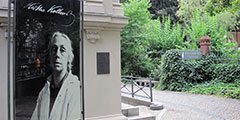Käthe Kollwitz was a leading German artist whose art explored the themes of hunger, war and persecution while criticising society and supporting the peace movement of her time.
Käthe Kollwitz (*1867 †1945) was born in Kaliningrad, Prussia. As a young woman, she studied art in Kaliningrad, Berlin and Munich. She moved to Berlin in 1891 with her husband. She became an art teacher and in 1919 a professor and the first female member of the Prussian Academy of Art.
Her etchings, drawings and woodcuts examine poverty, hunger, homelessness, the suppression of women and the revolt against exploitation. In 1914 one of her two sons died as a soldier in the First World War. This experience brought her into contact with the pacifist movement, and from then on she openly condemned the war and depicted its horrors in many of her works.
“I want to make a difference to act in this time when people are at a loss and in need of support.”
– Käthe Kollwitz
Käthe Kollwitz worked for the Internationale Arbeiterhilfe (Workers International Relief) and supported the socialist and anti-military movements of the day. In 1924 she designed the general assembly poster for ‘Anti-War Day’, a commemoration of the beginning of the First World War that was held annually to promote disarmament and peace. That same year, she also designed posters of protest against war and against the abortion clause for the ‘Socialist Workers’ Movement’ and the Communist Party.
A recurring motive in her work is parents’ pain over the loss of their children through famine or war. Two of her most famous works are the sculpture Mutter mit totem Sohn (Mother with Her Dead Son) in the Neue Wache in Berlin—a controversial place of remembrance—and the sculpture Trauerndes Elternpaar (Grieving Parents) at the soldiers’ cemetery in Vladsloo, where her son is buried.
In 1936 she signed the Dringenden Appell (the Urgent Call for Unity) against National Socialism, and as a result was forced to resign membership of the Akademie der Künste (Academy of Art). Her works were also removed from the academy’s collection, which amounted to a professional ban. She died in Moritzburg in 1945, a few days before the end of the war.
In 1922 she wrote in her diary: ‘When I think that I have worked in an international community against the war, I have a warm, flooding feeling of satisfaction (…) I agree that my art should serve a purpose. I want to make a difference in a time when people are at a loss and in need of support’.
Food for thought: What is the role of pacifism in your country today?





